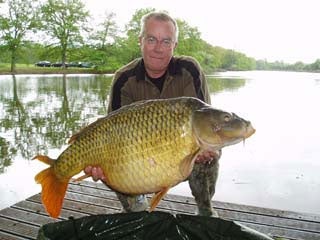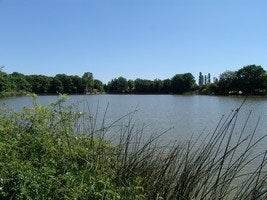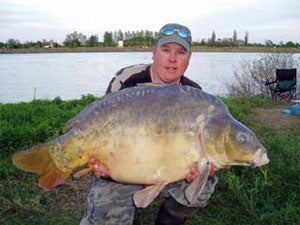A History of a French Carp Water – Moorlands FisheryThe Fishery and FishTHIS ARTICLE HAS been quite some time in the planning and thinking stage and that in turn has been generated by quite a few of my customers, now good friends, remarking on the original ‘Live your dreams’ articles and asking for a follow up. I’m not sure that this will ever be published in the magazines because it will probably be seen as being too much of an advertisement but it is truly a conglomeration of lots of discoveries and questions that have been uncovered as I have developed the fishery.
In order to start at the beginning I need to go back to mid 2001 when we first agreed to buy the lake. We were given details, and indeed photos, of the fish stock and we paid a premium price for the property because I believed that the fishery was virtually ready to roll and would only need ‘tweaking’ to make it top class. The alarm bells started ringing We moved in in January 2002 and alarm bells began to ring when we found that even the light switches were missing. Anyway, we had been given to understand that there were several thirties and two forties already stocked by one of the previous owner’s friends. As soon as we were in I started to fish the lake while carrying out the normal decorating and other ‘simple’ jobs such as building a dining lodge and cutting swims. In short I struggled to regularly catch fish above twenty pounds and discovered that the lake was teeming with low doubles and singles with the majority of them being commons.
Eventually I did manage to catch a 32lb mirror, a fish which is now named ‘The Slag’ because everyone’s had her. It also became rapidly evident that the lake had millions of roach, crucians, etc. and the decision was taken to empty it as soon as the 2002 season ended. In the meantime, in order to at least provide a reasonable quality of fishing, we purchased 50 upper doubles and low twenties from a local fish farmer, M. Denderes. The Vidange (Emptying) As soon as October arrived we started the vidange with the assistance of Monsieur D and I can vividly remember the astonishment of seeing the fish spread across the mud as the water disappeared. The first result was confirmation that the promised big fish simply weren’t there. The only thirties were ‘The Slag’, which by now had dropped to 27lb because of the use of tiger nuts, and a beautifully plated carp of 34lb which had never been landed. What weight had she been in her prime assuming that the tigers had made her lose weight in the same way? I made two major mistakes at this point, one was removing everything that wasn’t a carp and the second was not taking notice of the fish farmer. As we sorted the fish he informed me that some of the fish had the appearance of wild river carp, long and lean. I was worried that to remove these fish would reduce the stock to a level that would not provide sufficient action for the anglers. As it turned out the end result was that we left in too many carp and too many low doubles were caught during 2003. that was also the year that the carp spawned like I have never seen before and the water level dropped like I never want to see ever again. I had decided to empty the lake again to remove the small male or wild commons but this plan was immediately halted by the news that no vidanges would be allowed during 2003 because of the overall water levels. Without being able to drain the lake we decided to raise the level by building the overflow control higher by 12 inches. In fact we raised this again by another 6 inches and our calculations showed that over the surface area of the lake plus the extra water which is held back in the feeder streams we have added well over six million gallons to the volume. We had to bite the bullet in order to provide reasonable quality fishing and in February 2003 we were told of a batch of carp for sale which included 30’s and 40’s. We drove half way across France to the Brenne national park and chose individual fish from the tanks of a ‘professional’ fish producer. The fish had already been netted from his lakes and were corralled in concrete tanks. We then had to drive like maniacs to keep up with his delivery driver while water spewed from the doors of the van at every corner and roundabout. It was probably at this point that I started to question the system employed in order to provide or purchase carp in France, but more of that later. Reasonable growth rates Even though the lake was overstocked with carp we still noticed reasonable growth rates on the fish, probably because there weren’t any other species, except for a few roach as catfish food, to compete with, and summer 2003 produced some regular captures of 30’s and the occasional 40. In November 2003 we had one of our farming friends suddenly turn up at the gate waving his arms about and telling us that there was a local lake being emptied and it should hold some big carp. We followed him to the site and arrived as the last of the fish were being scooped out of the mud of a five acre pond. We weren’t really ready to buy any more fish and couldn’t understand how this village had got permission to empty when nobody else could, but there in the tanks were about ten beautiful mid twenties and one grass carp of about thirty pounds. The price they were asking was ridiculously low and I would have been stupid not to buy them. We raced home, got the trailor with some tanks on the back, and collected our new stock. To my surprise the fish started to grow immediately. A bloody nightmare The year 2004 was a bloody nightmare with thousands of baby carp trying to eat everything that they could find. We added perch and catfish in an attempt to eat the problem away but we would have needed over 100 big cats to even make a dent in the numbers of carp.
November 2004 arrived and this time we decided that we were going to be ruthless with the drain-down and remove anything that wasn’t suitable for the anglers. We decided to do all the work ourselves and spent three weeks in chest waders netting individual fish as the water gradually dropped. At the final weekend we resorted to calling in M. Denderes again just to cart away over three and a half tons of baby carp. On top of this we removed all of the lean, male-shaped carp which we thought were possibly the ones to which he had referred. The total of large carp (between 12 and 23 lb) removed was over 100 and, as M. Denderes had alluded to them possibly being river fish, we decided that the only fair thing to do was to return them to the river to live out the remainder of their lives. Once this work was complete we also purchased some more cats and a large quantity of big perch in order to eat any fry produced. Amazing growth rates and spectacular catches With the reduced stock levels 2005 produced some amazing growth rates and some spectacular catches. Forties became much more regular and we even began to see occasional fifties. These results helped to calm our nerves and proved that overstocked fisheries were certainly not the way to go. The decision was made to only purchase a few hand-picked fish each year and these should replace any ‘natural losses.’ During the summer of 2005 we decided that we had made another mistake by leaving in the roach and rudd. At the time the thinking behind this had been to provide food for the cats but the silver fish proved to be very adept at spawning and producing numerous offspring so the cats weren’t being caught. Simply they had more food than they could cope with and didn’t need to eat angler’s baits. Yet again we decided to drain-down in December 2005 and remove the silver fish. Just before we were ready for the drain-down we received a phone call from one of our French angling friends. Were we interested in some big carp that one of his friends was about to move from his pike lake. Obviously we were interested but why was he getting rid of them? Apparently he has a lake which he uses to produce pike for the table and he sells them to local restaurants. Because small carp are so cheap to buy he stocks the lake each year with fingerlings for the pike to eat but some evade being eaten and outgrow the predators. Every now and then he empties the lake and removes the carp. When I asked what he would do with them if we didn’t buy them the answer came back ‘Oh just throw them in the river.’ Needless to say we looked at and bought the three upper thirties that he had on offer. English anglers who wanted to buy large carp In the middle of our 2005 drain-down action we were informed that there were a batch of wide mouth bass for sale at Tournus. On our trip to view these fish we passed the five acre pond which had been vidanged in 2003 and saw a sign giving the dates for another drain-down. Apparently this pond is drained down every two years. Out of pure curiosity we attended the drain down and were astonished to see, and buy, another dozen mid twenties plus a couple of low thirties and one beautiful 38lb mirror. I couldn’t believe my eyes and asked how on earth fish could reach this weight in two years to be told that the local people only buy the smaller carp (for the table) and the larger carp are put back to grow bigger after each vidange. This sounded feasible but during the previous vidange we had bought all of the big carp so any fish which were ‘put back’ would not have been in the twenties range so where did these big fish come from? It was quite unusual to hear them say openly that ‘now that they had English anglers who wanted to buy large carp it was worth them keeping the big fish in the pond whereas in the past they would have been killed or put back into the river.’ I couldn’t help wondering whether they had seen an opening to make an extra few bob and were manipulating the rules to suit their pockets. There were certainly a good number of local anglers at each vidange. Throughout 2006 the stocking levels seemed to work very well. The fish were packing on the weight and the anglers were catching numerous thirties and we even managed to bank exactly 100 forties so I was happy that we were now on the right route and would soon be a top flight carp fishery. I am now expecting 2007 to be very special and I can’t wait to see what top weights we eventually achieve. Questions, questions… Looking back I have some questions going through my mind, most of which I don’t have, and probably don’t want, answers to. When we go to ‘legitimately’ purchase carp in France we don’t have a clue about their lineage. Where do they come from before we choose them from the stew ponds of a fish farmer? Has he really grown them on in his rearing ponds for the last eight years? Has he really just been and netted a private lake down the road? I have asked to be allowed to go with them to help with the netting and I am deterred each time with the excuse that if the owner sees an English lake owner he will put up the prices. Did the three thirties that we bought from one of our friends really develop from fry which were introduced to his friend’s pike pond as food fish and which then avoided being eaten and grew to be too big until he had to empty it? Where do the local villagers buy their stock fingerlings from to be able to grow to thirty pound plus in, let’s say, four to six years? I haven’t got answers to any of those questions and, I’ll be honest, if I turn up at Etrigny for this year’s vidange and there are mid twenties and above again I won’t hesitate to buy them. From my past experiences I have discovered that the carp bought from small local ponds and then introduced into our 15 acre lake grow like you wouldn’t believe. It appears that they are stunted in the small pond and then given a massive boost with the extra room in our lake. Long may it continue but as a guide to the ‘Moorlands lineage’ here are some of the known fish and their personal history. ‘The Slag‘. My first thirty from the lake and one of the originals. Best weight in 2006, 37.04 lb. I hope you’ve enjoyed this potted history and also that you catch the fish of your dreams. Keith Moors |
Welcome!Log into your account
















